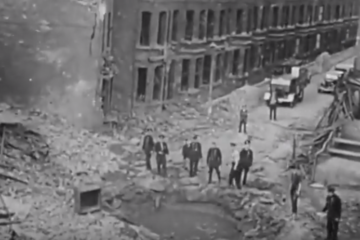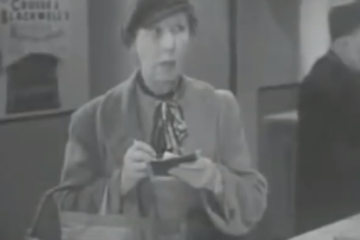With the fall of France imminent, Hitler had the bulk of Western Europe either directly under his control, neutral or allied to him. For the first time since the Napoleonic Wars, Britain faced both isolation in Europe and the prospect of invasion. On May 14th, barely two weeks before the evacuation of the British Expeditionary Force (BEF) from the beaches at Dunkirk, Anthony Eden in a radio broadcast called for volunteers among men ‘not presently engaged in military service between the ages of 17 and 65 to come forward and offer their services’. The response was enthusiastic, the new army was known as the Local Defence Volunteers ‘rechristened parashots in some rural areas.’[1] Following a speech given by the new Prime Minister in July 1940, the term Home Guard became the new official title.
At first, the Home Guard was an improvised force, the first citizens’ army since the threat of French invasion in 1803, the various units, hastily raised, elected their officers and armed themselves with a range of home sourced weaponry ; ‘aged rifles, shotguns, cutlasses, broomsticks converted into pikes’.[2] Over the course of the war and until September 1944 when the Home Guard was stood down, its role was to be a key line of defence; in terms of organisation, specialisation and professionalisation it developed into a formidable force. Commissions were available from May 1941 and women were admitted from April 1943.[3] Individual units developed specialisms in street fighting, river and horse patrols and there were even commando units specially trained should the Germans invade and secure a foothold in Southern England.[4]
Nationally, the Home Guard was divided into seven command areas which in turn were divided into smaller areas (zones, sectors, districts and sub districts). These were then divided into battalions. The latter were then divided into companies each of which was further divided into platoons. By 1944, there were twenty nine different Home Guard battalions in Surrey in two command areas, London and Southern Eastern.[5]
The 10th (Egham and Chertsey Battalion) Home Guard
It is impossible give a precise figure as to the strength of the units. The 10th Battalion was composed of 13 companies. Officially, a company had 1600 men, each company being divided into four or more platoons comprising about 400 men in each.[6] However, this was at best a rough guide with a degree of variance in numbers, rural units could be considerably smaller. There was also a practice of transferring of recruits within the 10th Battalion from one company to another. In early 1943, for example, records show that significantly more than usual numbers of men were being transferred (231 in January and 171 in February) followed by 128 in June. Any conclusion as to the reasons why is tentative, although the main beneficiaries were company F which received an additional 394 recruits between January and February and Company H which received all of the transferred recruits the following June.[7] The only confident conclusion is that the authorities were in general concerned over recruitment and retention of recruits in an organisation whose potential role was considered of real importance to the functioning of the war effort. This can be deduced from the fact that from early 1942, membership of the Home Guard was made compulsory.[8]
Overall structure at a battalion level, included two headquarters- administrative and battle commands (for the 10th Battalion, the administrative HQ was Bears House, Wentworth (Virginia Water) with the battle command at Trotsworth Farm, Virginia Water.[9] Below this level, each of the thirteen companies, had its own administrative and battle commands. As one of the duties of the Home Guard was the protection of key installations and facilities such as factories and public utilities, these often were the focus of the organisation of home Guard units, even drawing their membership from among the workforce based there. Commercial companies themselves took a key role in the creation of Home Guard units based at their premises; soon after Eden’s call for local volunteers, the National Gas Council asked gas companies in and around London to draw up list of volunteers willing to guard against saboteurs and ‘similar requests were also made of workers employed in other public utility companies’.[10] The Lagonda Works at Egham Hythe, the Gas Light and Coke Company, The Causeway Staines, The Fairey Aviation Company at Addlestone, The Veterinary Laboratory at New Haw (Addlestone), Hunt’s Factory at London Road, Virginia Water were all locations of platoon headquarters for the 10th Battalion.[11]
The command structure of the 10th Battalion was a complex interlocking system, deliberately designed in a manner which would allow easy communication between units. From their early days, the key function of providing observation meant that Home Guard units had to ensure that they were in close contact with other military authorities and with local branches of civil defence; ‘any enemy infiltration had to immediately be reported and it was vital that this information be passed on as soon as practically possible.’[12] This was prepared in the form of battle plans, among the best surviving of these was that drawn up by Lieutenant J.H.A. Whitehouse of the 10th Surrey Battalion in April 1943. He drew up a map of the area covered by the battalion on which were indicated locations of the other companies and platoon headquarters and the neighbouring Home Guard Battalion headquarters and those of the National and Auxiliary Fire Services, ARP Police and observer companies. The plan also ‘showed the various telephone lines available at each post. These were either existing or prepared field lines set up by the Home Guard or circuits used by the ARP or NFS.’[13]
“Such a force is of the highest value and importance. A country where every street
and every village bristles with resolute, armed men is a country against which the
tactics that destroyed the Dutch will not succeed…………a country so defended
would not be liable to be overthrown.” (Winston Churchill)
The Home Guard grew into a substantial force of some 1.7 million men. Ultimately, it was never put to the ultimate test of acting as a line of defence against an invading enemy. Nevertheless, considerable efforts had been made to prepare for such an outcome. The former International Brigader, Tom Wintringham set up a commando school at Osterley park, to train Home Guards in guerrilla tactics which he had learned during the Spanish Civil War (1936-9). Later, three other commando schools were established.[14]
To conclude, the popular image of the Home Guard is defined by the comic image developed in the long running television series, ‘Dad’s Army. Yet, as testament to the worth and value which contemporaries attached to the organisation is the honour of mounting a guard at Buckingham Palace in 1941 and again in 1943, an honour granted to such a newly formed unit had not been granted to regiments formed several hundred years previously.[15]
APPENDIX 1
Commanding officer 10th battalion (Egham and Chertsey) Lt. Col. APY Langhorne and 2/ic. Major E.D.H. Tollemache
| Company | Commander | 2 i/c | Admin HQ | Battle HQ |
| A | Major R.G. Buxton | Captain J. Hepburn | Old Police STN Egham Hill | As previous |
| B | Major J. Rawlinson | Captain M.G. Nicholls | Kingbourne, Pinewood Road, VW | As Previous |
| C | Chapel fields, Simple Marsh Road, Addlestone | As Previous | ||
| D | Drill Hall, Chersey | |||
| E | Major P.D.H. Barca | Captain F.L. George | 10 Thorpe Road, Egham | |
| F | Fairey Aviation Company, Addlestone Road, Weybridge | |||
| G | The Hut, Veterinary Laboratory, Woodham Lane, New Haw, Addlestone | |||
| H | Captain L.M. Bright | Captain H. Ware | The Hut, Wickham Lane, Egham |
APPENDIX 2
Units of the Egham and Chertsey Battalion based around Egham
A COMPANY Old Police Station Egham Hill
| Platoon | HQ | commander | 2 i/c |
| 1 | Post Office Egham | Major R.G. Buxton | Captain J. Hepburn |
| 2 | Englefield House, Englefield Green | Lieutenant C.F. Nichol | Lieutenant K.C. Taylor |
| 3 | Stanley Engineering Company, The Avenue, Egham | Lieutenant E.L. Blay | 2nd Lieutenant L.S. Dodson |
| 4 | Old Police Station, Egham Hill | Lieutenant A.F. Oliver | Lieutenant H. Branson |
| 30 | As Above | Lieutenant J. Harvey Pickup | Lieutenant W. Beckett |
| 31 | Bakeham House, Bakeham Lane, Englefield Green | Lieutenant T.H. Warren | Lieutenant A.C. Hawthorne |
E COMPANY Thorpe Road Egham
| Platoon | HQ | Commander | 2nd |
| 42 | Lagonda Works | Lieutenant Smethurst | 2nd Lieutenant Laingley |
| 23 | Lagonda Works | Lieutenant H.R. Masters | 2nd Lieutenant S.A. Heaven |
| 24 | Lagonda Works | Lieutenant A.T. Hawks | Lieutenant C.G. Barnes |
| 25 | Lagonda Works [Iron Harks] | Lieutenant J.W. Phillips | 2nd Lieutenant W.W. Carmichael |
| 26 | Lagonda Works [Iron Barks] | Lieutenant W.W. Mileham | 2nd Lieutenant V.R. Brickstock |
| 27 | Lagonda Works [Iron Barks] | Lieutenant H.J. Foley | Posted |
| 34 | The Gas Light and Coke Company, The Causeway, Staines | Lieutenant J. Bowman | J.W. Tate |
H COMPANY The Hut Wickham Lane Egham
| Platoon | HQ | Commander | 2nd i/c |
| 29 | Egham Hythe Mission hall, Wendover Road, Staines | Lieutenant H.E.P. Goodwin | 2nd Lieutenant C.Cooke |
| 33 | Army Hut, Rosemary lane, Thorpe | Lieutenant Hews | 2nd Lieutenant J.W. Tubb |
| 35 | Dunn’s Engineering Company, Ten Acre Lane, Thorpe | Lieutenant E.A. Paget | 2nd Lieutenant P.E. Chards |
| 46 | Mission Hall, Wendover Road, Staines | Lieutenant F.L. Mitchelson | 2nd Lieutenant E.E. Elsey |
[1] Bob Ogley Surrey at War 1939-1945, p. 31.
[2] Ibid.
[3] Paul Crook, The Surrey Home Guard, p.5
[4] The Chertsey Home Guard had a bicycle patrol which toured through the town, setting off from the Drill Hall and cycling down London Street, Windsor Street, Staines Lane, in to Thorpe, round Lyne, in to Ottershaw and back along Guildford Road and Eastworth Road before returning to the Drill Hall. A similar patrol was established in Egham. www.chertseymuseum.org.
[5] Surrey History Centre, Surrey Home Guard Records 1940-1945
[6] Ibid. Evidence that platoon size varied can be seen in the formation of Norwegian attachment to B Company of the 10th Battalion. The platoon, made up of Norwegian sailors grew to about 50 and was a distinctive unit, members were allowed to wear the Norwegian flag below the flash in their uniform- see Bob Ogley, op.cit., p.32.
[7] Surrey History Centre, 477/7/1- Records of the 10th Battalion. In two cases, transfers were made to outside the county- One was to North Lodge, Botley in Oxford and another was to the 1st Middlesex Battalion.
[8] Peter Crook, op.cit.
[9] SHC 477/3/2; File containing Transcript list of officers and companies (1th Battalion, Surrey Home Guard) 1944.
[10] Peter Cook, op.cit., p.67.
[11] Ibid. In fact a number of the platoon headquarters were based at the Lagonda works. The Lagonda Factory was a large complex ; ‘the company made rocket tails, flame throwers, anti tank gun carriages, parts for Crusader Tanks, engines for patrol boats, RAF trailer equipment, shells, depth charges and aircraft equipment’; see Bob Ogley p.155.
[12] Ogley, Op Cit., p.53.
[13] Ibid.
[14] https://www.historylearningsite.co.uk/world-war-two/world-war-two-in-western-europe/britains-home-front-in-world-war-two/home-guard/



0 Comments